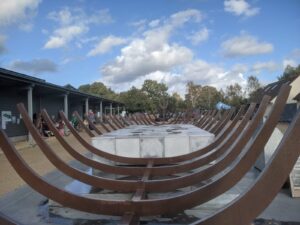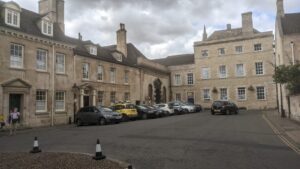Stamford (July 2022)
On 25 July 2022 we travelled to Stamford in Lincolnshire
Described as “the finest stone town in England” it was declared a conservation area in 1967 and has over 600 listed buildings including five medieval churches.
On arrival we were met by our guide and then had time for coffee before starting our walking tour of the town. Noted for its Georgian buildings , it was interesting to hear of those who had lived there and influenced the development of the town. Often used in the filming of period dramas, Middlemarch, Pride and Prejudice were shot here.
There was plenty of time for lunch and then to discover places we had seen on the walk and it was a very successful journey out.

Ickworth (May 2022)
What a day! It started raining as we neared Bury St Edmunds and didn’t stop all day! However this did not spoil the enjoyment of members who visited the cafe for coffee and lunch, visited the house and walked the gardens and the grounds.
Ickworth is a National Trust property. Its origins can be traced back to the Domesday book when it was merely one of hundreds of assets belonging to the Abbey of Bury St Edmunds. Its association with the Hervey family began three centuries later in 1432, when Thomas Hervey acquired the land by marriage. Through success and scandal, Ickworth was the family’s home for the next 500 years.
Ickworth was designed to impress. It was built as an 18th century palace to showcase the many treasures and art collected by the Earl Bishop who despite being a third son, inherited the Estate in 1779. He was the 4th Earl of Bristol Started in 1795, the building was still just a shell when he died in 1803 and his son was left to complete his vision. The house has an amazing Rotunda. Nothing like it had ever been seen in this country before and even now it’s unique. The House took 47 years to complete. In 1829, the family moved into the East Wing of their (nearly finished) palatial new home. Surrounded by beauty, both inside and outside, the Herveys enjoyed Ickworth until well into the 20th century.
The Earl Bishop had spent his life travelling in Europe and secured a vast collection of art and treasures. There is a wonderful collection of pictures…Titian, Reynolds and Gainsborough being amongst the artists and there are some fine sculptures. The silver room houses the largest collection of silver within the National Trust and has some wonderful examples of how the wealthy wined and dined.
The Hervey’s tenure at Ickworth came to an end in 1956 when the 4th Marquess presented the house and estate to the Treasury in lieu of death duties. The Treasury passed Ickworth to the National Trust.
The Italianate Gardens and Stumpery were explored in the rain and we only wished we had seen them in sunshine!
Sutton Hoo (October 2021)
The first visit since March 2020 took place on Wednesday 20 October when a group of the Friends travelled with Flagfinders coaches and our special driver, Paul, to Sutton Hoo near Woodbridge.

Masks were worn on the coach and single travellers allocated two seats so distancing was observed.
Sutton Hoo is home to one of the greatest archaeological discoveries of all time.

In 1939, burial mounds in the grounds of a property owned by Mrs Pretty were excavated by Basil Brown, her gardener and amazingly the great ship burial was discovered. Other mounds had been previously dug and looted, but this was the most amazing discovery of the century. The mound he excavated was a royal burial ground, the final resting place of an Anglo Saxon king with his treasured possessions, Because of the imminence of World War II, Mrs Pretty made the generous decision to donate all the finds to the British Museum.
The site is cared for by the National Trust and recently they have made great developments. A 17 metre tall viewing tower has been erected opposite to the burial mounds and from here it is possible to get a real bird’s eye picture of the site and the proximity to the River Deben from where the ship was dragged to its final resting place.


In the courtyard, a full size sculpture of the ship has been erected which really gives an understanding of the size and the importance of the finds. The High Hall exhibition contains replicas of many of the treasures, including the iconic helmet, the gold belt buckle and a patterned sword. In Mrs Pretty’s home, Tranmer House, there is an exhibition to show various digs and excavations that have taken place at Sutton Hoo.
We were blessed with a mild sunny day and the opportunity to catch up with people who we had not met each other for over a year.

Saatchi Gallery – March 2020
Saatchi Gallery for the exhibition – Tutankhamun Treasures of the Golden Pharoah
On March 11 2020, a group of 43 members of the Friends embarked on a journey to London to visit the Saatchi Gallery and see the much praised exhibition, “Tutankhamun, Treasures of the Golden Pharoah”
It was a bright sunny day and we were able to enjoy and appreciate the London buildings as we moved slowly in the traffic. The streets were however remarkably empty of people with the travel restrictions imposed by the Coronavirus situation already affecting tourism.
Staged to celebrate almost 100 years of the tomb discovery (1922), some of the artefacts on display had not been out of Egypt before. Everything was well documented and because many exhibits were in central display cabinets, it was possible to walk around them and get quite close. Information was given above the displays and in several places short videos enhanced the understanding of the artefacts.
When the tomb was opened and Howard Carter saw the extent of the contents he must have been totally overwhelmed. Over 5,000 beautiful, richly coloured and decorated artefacts had been buried with the 19 year old king when he died to accompany him on his journey to the afterlife. These included a solid gold coffin, face mask, thrones, archery bows, trumpets, a lotus chalice, food, wine, sandals, and fresh linen underwear. The exhibition told the story of this journey.
Servants were in attendance and there were large containers which held food for the journey. There were bows and arrows, so he was prepared for attack. Many small icons were buried with him and the most beautiful gold and colourful jewellery. Chests were decorated with hieroglyphs and one of the final exhibits was the sarcophagus.
It was an exhibition which showed a wealth of opulence and beauty. It was difficult to comprehend that these artefacts were over 4.000 years old and yet the craftsmanship was intricate and exceptional. It was a truly memorable visit.







